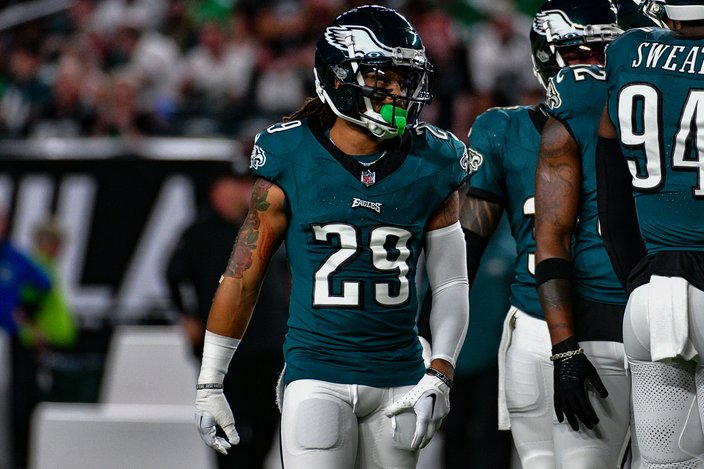
September 20, 2023
In the second quarter of the Eagles' 34-28 win over the Vikings Thursday night, Avonte Maddox moved in to tackle Alexander Mattison as the Minnesota running back tried to turn the corner toward the left sideline.
Maddox wrapped his arms around Mattison and pulled down, but the momentum from the collision took the both of them forward and the Philadelphia slot corner's arms back up awkwardly as they fell to the ground.
Upon the whistle, Maddox laid there on the field in visible pain and was just as soon ruled out for the remainder of the Week 2 contest.
The fear, and likelihood, based on reports from the day after was that Maddox had suffered a torn pec that would require surgery and cost him most, if not all of the regular season, and an MRI on Monday confirmed as much.
But Christopher Selgrath, DO could tell what Maddox's injury likely was from the start. Most doctors and trainers probably could.
"The muscle is pulling the arm in, the opposing force is pulling the arm out, then boom, it's torn," he said.
"You get the MRI for confirmatory purposes," he later added. "But you get a pretty good idea that it's torn just with physical exam."
And time to brace for what's going to be a long road back for a veteran corner who is crucial to the strength of the Eagles' defense and, ultimately, their Super Bowl hopes.
Dr. Selgrath offered an expert's take on the nature of Maddox's injury and what the recovery process might look like via a phone interview on Tuesday, along with an outside estimate for when he might eventually be able to return – or rather, how far the Eagles have to go for him to be able to.
Here's his read of the situation:
Eagles cornerback Avonte Maddox is looking at a long road back from a torn pec injury.
The pec muscle (Pectoralis Major) lies in the anterior chest wall and wraps around to the humerus bone in a person's arm and shoulder.
It's one of the muscles involved in rotating your arm, Dr. Selgrath explained, so usually when it gets injured or torn, as it likely did for Maddox, it's from an external force pushing the arm outward when the muscle is trying to move it in.
"So what happens is the muscle is getting stretched out, and then at the same time, the tackler, or somebody is pulling your arm as the muscle is trying to contract," Dr. Selgrath said. "Your muscle is trying to bring your arm in, but the force is just too much, and it gets forcibly externally rotated as you're trying to internally rotate, and then it just pops the muscle off of the humerus bone."
It's as painful as it sounds, and the surgery to repair it requires finding the tendon that popped loose – "sometimes it recoils back a little bit," Dr. Selgrath noted – and tying it back down to its original connection point on the bone called the "footprint."
A lengthy rehab process begins from there. "I usually break it into phases for patients," Dr. Selgrath said, with each typically spanning six-week intervals.
The first phase is biological healing. "You need that tendon to reattach to that bone, and that's biologic," Dr. Selgrath said. "So all I'm doing with my sutures [i.e. stitches] is putting the two together. Then the two have to agree to mend back together, right? So it takes six weeks for that to happen," and keeps the patient – Maddox in this scenario – in a sling to limit the range of motion so that the tendon can properly reconnect.
Phase 2 shifts to gaining the full range of motion back, because the whole operation moving from the chest into the arm is going to be tight and limited after so long, then the final stage gets back to building up strength and agility.
There's variation in that, of course, accounting for the fact that some just heal quicker than others, but generally, "it really could be a good 12-18 week injury," Dr. Selgrath said.
Which means, for right now at least, that a regular-season return for Maddox isn't looking too good.
"At best it's three months," Dr. Selgrath continued. "But I think that would be a stretch because you also don't want to re-injure it. You don't want to put him in harm's way from that standpoint. You want performance to be peak performance, right? So it's really not beneficial to go back and play, but the strength is only at, say, 70 percent.
"That's going to do him no good and it's going put him at an increased likelihood of injury because now you're re-doing what you tried to do the first time when you're at 100 percent, but now that strength is only at 70 percent. It's not a great idea."
Timing is everything though. A physical exam on the spot Thursday night likely gave the Eagles and Maddox a good idea of what they were dealing with immediately, Dr. Selgrath theorized, and an MRI to confirm and set up for surgery within the days that followed might make all the difference in the end for Maddox's playing status should the Eagles make it the whole way back again come February.
"High clinical suspicion, and then obviously get an MRI and then get him on the schedule [for surgery] as quickly as you can," Dr. Selgrath said. "Because a week could mean the difference between him playing in a Super Bowl or not playing in a Super Bowl."
The views and opinions expressed in this article are those of the author and guest authors and do not reflect any official policy or position of any NFL team or a team's athletic physicians.
Follow Nick on Twitter: @itssnick
Like us on Facebook: PhillyVoice Sports
 Kate Frese/For PhillyVoice
Kate Frese/For PhillyVoice